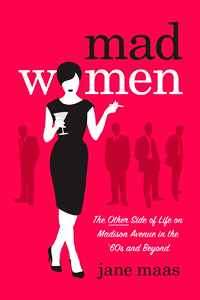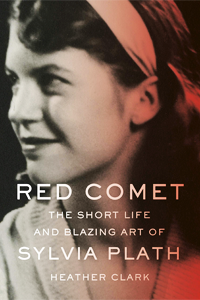Title Mad Women: The Other Side of Life on Madison Avenue in the ’60s and Beyond
Author Jane Maas
Published February 28th, 2012 by Thomas Dunne Books
Pages 272 Pages
Intended Target Audience Adult
Genre & Keywords Non-Fiction, Autobiography, Memoir, History
Part of a Series? No
Source & Format Gifted, Hardcover
Find It On Goodreads ● Amazon.com ● Chapters
Synopsis
What was it like to be an advertising woman on Madison Avenue in the 60s and 70s – that Mad Men era of casual sex and professional serfdom? A real-life Peggy Olson reveals it all in this immensely entertaining and bittersweet memoir.
Mad Women is a tell-all account of life in the New York advertising world by Jane Maas, a copywriter who succeeded in the primarily male jungle depicted in the hit show Mad Men.
Fans of the show are dying to know how accurate it is: Was there really that much sex at the office? Were there really three-martini lunches? Were women really second-class citizens? Jane Maas says the answer to all three questions is unequivocally “yes.” Her book, based on her own experiences and countless interviews with her peers, gives the full stories, from the junior account man whose wife almost left him when she found the copy of Screw magazine he’d used to find “a date” for a client, to the Ogilvy & Mather’s annual Boat Ride, a sex-and-booze filled orgy, from which it was said no virgin ever returned intact. Wickedly funny and full of juicy inside information, Mad Women also tackles some of the tougher issues of the era, such as unequal pay, rampant, jaw-dropping sexism, and the difficult choice many women faced between motherhood and their careers.
“Was it really like that?”
As soon as people find out I actually worked at an advertising agency in the Mad Men era, they pepper me with questions.
“Was there really that much drinking?” “Were women really treated that badly?” And then they lean in and ask confidentially. “Was there really that much sex?”
The answer is yes. And no.”
If you’re anything like me and can never get enough of AMC’s much celebrated, award-winning series Mad Men, then Jane Maas’ Mad Women: The Other Side of Life on Madison Avenue in the ’60s and Beyond is the book for you! A memoir written from the perspective of a woman who experienced it all firsthand, Mad Women is a fun, and occasionally surprising, romp through what is often considered the golden age of advertising. I received this book as a gift from my mother this past Christmas after bemoaning the fact that I still had what then seemed like an interminable four months to wait until the premiere of Season 6 of Mad Men. I’m happy to report that this book more than satisfied my longing for anything and everything related to what remains one of my favourite television shows of all time and is a book I would highly recommend to fans of AMC’s Mad Men or those with a general interest in the history of advertising or in the perspective of a working woman in the 1960’s.
“There’s a coffee shop next door to the office, and I stop in to pick up a cup. I’m at the front of the long line waiting to pay, and I spot an art director who works for me at the tail end. “Go on up, Doug, I’ll get this.” He motions his thanks. The male cashier beams at me. “Well, aren’t you the nicest little secretary to buy coffee for your boss. Hope he appreciates you.”
Another day on Madison Avenue.”
As the book description mentions, the author’s gradual rise through the advertising professional ladder is not unlike that of the beloved character Peggy Olsen. Initially a producer for the quiz show Name That Tune, Mass went on to work as a copywriter at the agency Ogilvy & Mather from 1964 to 1976 before eventually moving on to work at Wells Rich Greene after being given the promise of a senior vice presidency and an additional twenty thousand dollars a year. Well respected and undeniably successful, there Maas eventually went on to spearhead the well-known and absurdly successful “I Love New York” advertising campaign.
“We have several women writers because we work on “packaged goods” – the kind of products you find on supermarket shelves; the kind of products women are allowed to write ads for, like Dove soap, Drano, and Vanish toilet bowl cleaner. Down the hall, a creative group works on Mercedes-Benz; it is all male. One floor above us, another creative group handles the American Express card – all male. Only men are considered good enough to work on luxury accounts like Steuben Glass or liquor accounts like Rums of Puerto Rico. I’m told that at a rival agency, the chief copywriter on Kotex is a guy.”
The book itself is a series of anecdotes structured into a number of different chapters, each addressing a particular theme or topic that is relevant to Mad Men. From the subject of women in the workforce (Chapter 3: “Get the Money Before They Screw You”) to liquor consumption in the office (Chapter 5: “The Three-Martini Lunch and Other Vices”) Maas covers it all in bold, unflinching recollections of her own experiences as well as those of her close friends and colleagues. She also provides a helpful introduction to the history of advertising, discussing the various strategies of the time and successful examples of their work, including the Doyle Dane school of advertising, best typified by the Volkswagen Think Small and Lemon ads that simultaneously perplexed, angered and intrigued Don Draper and company in Mad Men‘s season one episode, ‘Marriage of Figaro’.
“The term ‘working mother’ was an oxymoron in the 1960’s. It was almost unheard of for the mother of children under ten or twelve to work full-time unless the family badly needed the income. Men felt vaguely sorry for working mothers; we must be married to real deadbeats. Women, especially other mothers, were usually shocked to learn we were letting other people raise our children. The term ‘stay-at-home mom’ had not yet been invented; there was no need for it. That’s what moms did; they stayed home.”
From sex in the office, adulterous or otherwise, to liquid lunches, Maas manages to seamlessly relate her own personal experiences and those of her colleagues back to Mad Men, demonstrating that the television series, as unbelievable though it may sometimes seem, gets it right more often than not. Like the often maligned divorced and single working mother of two, Helen Bishop in Season 1 and 2, Maas faced criticism and scorn for working outside of the home in a decade when being a housewife was considered a woman’s most noble and important profession. Often feeling guilty for prioritizing her job over that of her children, Maas also had the deal with the disapproval of both her colleagues and other women regarding her prioritization of the professional realm over the personal.
“I don’t remember what the mother’s name really was, but she was a good mother. I don’t think I am. My priorities are job first, husband second, children third. It’s the only way for a woman to survive in the advertising business. And in the marriage business.”
In one of the most striking passages, Maas recalls an ordinary day in her life in order to paint a picture of what it was like for a woman struggling to make a place for herself in what was then a predominantly male-dominated business while also balancing the responsibilities of being a wife and mother. What is ultimately revealed is the all-consuming sense of guilt Maas experienced as she and other women attempted to perform a tenuous balancing act in which they was constantly forced to choose between personal and professional considerations, particularly when one or more of these priorities inevitably fell by the wayside. In the final chapter of the book, entitled “Have You Really Come Such A Long Way, Baby?” Maas examines the evolution of women’s role in the workplace and home. She comes to a rather dour, though not altogether surprising, conclusion that will have readers reflecting upon hours after they have finished reading.
“Get the money before they screw you, darling,” she said. “Before they screw you the way they screwed me.”
The author does periodically stray from the intended path to indulge in the occasional reminiscence, like her time spent at Bucknell University or the last-minute wedding and reception she organized for then-Governor of New York, Hugh Carey. As interesting as some of these stories were, they bore little, if any, relevance to the subject at hand. Unfortunately, it was this occasional inability to stay on message that prevented this book from receiving a perfect rating, something it might otherwise have rated.
“Men thought it was bad enough that they had to put up with women other than secretaries, but at least with a single woman the guys could make passes all day long without feeling guilty. As soon as a woman got married, she became a time bomb: a potentially pregnant woman. No agencies wanted large-bellied women hanging about. They set a bad example for other women, and they were terribly upsetting to the men who worked with them. A man couldn’t criticize them; their hormones were unbalanced now, so they might cry. A man couldn’t ask them to bring him coffee or pour a drink or lift an ashtray; they might give birth right there in the office. So the best thing to go was get rid of them as quickly as possible. And not invite them back.”
Mad Women is written with a wit and vivacity in a matter-of-fact voice that will appeal to even the most reluctant non-fiction reader. Filled with a perfect combination of both hilarious and cringe-inducing anecdotes, such as the time a client took an impromptu swim in the decorative stream at Nippon after one too many martinis, Mad Women is a fast-paced, easy to read memoir that transports you to a different era, one in which working women often had to make the hard choice between self-respect and getting ahead, no matter what the cost to themselves. While the scope of Maas’ investigation is undoubtedly limited, arising solely from the perspective of an affluent, well-educated, Caucasian woman, Mad Women is still an interesting and relevant addition to the non-fiction genre.
As an additional aside, I simply have to take a moment to mention how much I adore this book’s cover. Designed and illustrated by Angela Goddard and Nicemonkey, Mad Women’s cover is bright, colourful, retro and delightfully adorable. It’s certainly one I’m proud to display on my bookshelves!

Overall Rating


Around The Web
Still not sure this is the right book for you? Why not listen to what some other bloggers had to say about it?
● Monique @ So Misguided wrote “I absolutely loved this book. Every woman (and man) who loves Mad Men should read Mad Women by Jane Maas, which is about what it was actually like to be in advertising in the 60s.” (Read the rest of the review Here!)
● Anita @ Keep Reading & Writing wrote “For me, this memoir was hard to enjoy. Maas generalizes things that happened in the past, which made it hard for me to keep interested. I wanted more detailed stories and specific instances.” (Read the rest of the review Here!)
● Melissa @ The Written, Spoken & Visual Word wrote “I’m going to leave this one up to you – the subject matter was really interesting but the writing style was mediocre at best.” (Read the rest of the review Here!)












8 Responses
Sounds fascinating. I can’t wait to read this one!
It’ll be a great way to fill the void once Mad Men’s season finale airs this Sunday 😉
I’d been curious about this one, but hesitant to venture into nonfiction, since it can be so dry. Since you loved it, I think it’s going on my to-read list!
I quite enjoyed it and read it in a matter of hours one afternoon 🙂 That said, I’m a huge fan of the non-fiction genre in general so my tolerance for dry prose might be a little bit higher than most. Maas does write in a more conversational style that I think will appeal to those who are reluctant non-fiction readers and I absolutely loved some of her anecdotes. I think an interest in Mad Men might help, but isn’t a necessary prerequisite for enjoying this book.
I really hope you like it, Christina 🙂 And thank you so much for taking the time to comment!
I really enjoyed this book, too. Though at times it did seem to stray off topic, I thought it was an fun read, especially for nonfiction/memoir.
Great, in-depth review!
Thank you so much for your kind comment! 🙂
I’m glad to hear that you enjoyed the book as well. Had Maas been able to stay more solidly on message, I definitely would have had no problem awarding this book five stars. It was a lot of fun to read and I loved to hear stories from the perspective of a woman who actually lived through it all, despite how limited and specific her perspective and experiences might have been.
After I finished watching all 5 seasons of Mad Men that were available on Netflix, I whipped together a reading list of books that took place in the Mad Men-era, or were relevant to it, and Mad Women was one of them to keep me in the world of Mad Men. I loved Maas’ anecdotes, and the wit with which she delivered some semi-antiquated thoughts on gender roles in that time to a modern audience. I especially love the little anecdote you highlighted where she offered to get coffee for her co-worker and was thought of as the secretary. Now I just need to get onto season 6…
Courtney @ The Lit Girl recently posted…Newcity Lit Review
That is such a great idea! I’ve tried to read every Mad Men-themed book I could get my hands on as well. If you haven’t read it already, I would also recommend Mad Men Unbuttoned: A Romp Through 1960s America by Natasha Vargas-Cooper 🙂 Although it has been a couple of years since I last read it, I remember greatly enjoying it and it left a really positive impression!
P.S. Mad Men season 6 was fantastic (Not that I ever expect anything less from that series) I really hope you enjoy it 😀 Vincent Kartheiser deserves all the awards for his work this past season – He was absolutely great and stole every scene he was in.
Jen @ Pop! Goes The Reader recently posted…Top Ten Books I’m Most Intimidated To Read